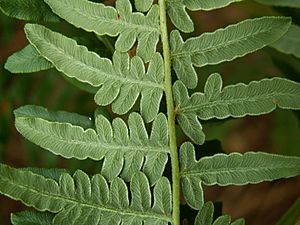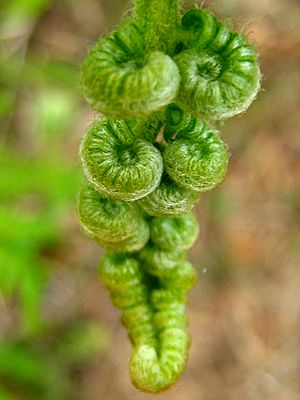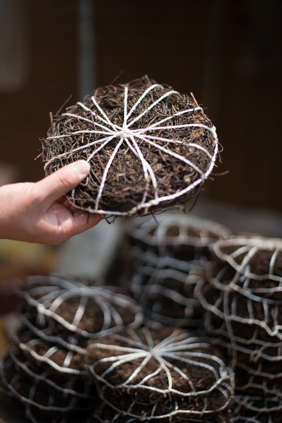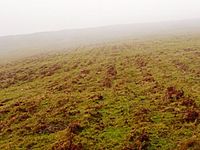Bracken facts for kids
Quick facts for kids Bracken |
|
|---|---|
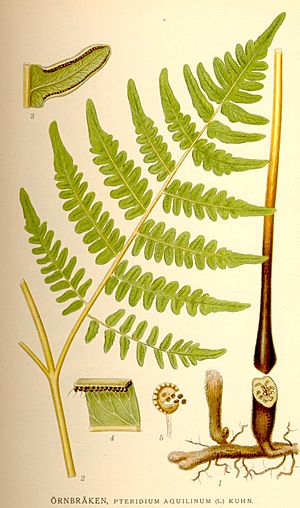 |
|
| Pteridium aquilinum | |
| Scientific classification |
|
| Kingdom: | Plantae |
| Clade: | Tracheophytes |
| Class: | Polypodiopsida |
| Order: | Polypodiales |
| Family: | Dennstaedtiaceae |
| Genus: | Pteridium Gled. ex Scop. 1760 not Raf. 1814 (Pteridaceae) |
| Species | |
|
See text |
|
Bracken (Pteridium) is a type of large, tough fern. Ferns are vascular plants that don't have seeds. Instead, they produce tiny spores. Bracken ferns are known for their big, divided leaves. You can find them on every continent except Antarctica, and in most places except deserts. They especially like moorland areas. This makes bracken one of the most widespread ferns in the world!
The word bracken comes from an old Norse word. It is similar to the Swedish word bräken and the Danish word bregne, both of which mean fern.
In the past, people thought there was only one type of bracken, called Pteridium aquilinum. But now, scientists divide it into about ten different species.
Like other ferns, bracken does not have seeds or fruits. Its young, curled leaves are called fiddleheads. Some people eat these, but it's important to know that some types might not be good for you if not prepared correctly.
Contents
What is Bracken?
Bracken is a very successful fern. It can spread quickly and grow well in acid soils. It is often seen in moorland areas, especially in places like northern England, where people sometimes call it 'Moorland Scrub'.
Bracken is also a very old plant. Scientists have found fossils of bracken that are over 55 million years old! This plant grows large, triangular leaves from a wide underground root system. This root system can spread a metre or more underground between leaves. The leaves can grow very tall, often between 0.6 and 2 metres (2 to 6.5 feet) high. In cold places, bracken leaves die back in winter. It usually grows on hillsides because it needs soil that drains water well.
Ferns produce tiny spores to reproduce. These spores are found in special structures called sori on the underside of the leaves. In bracken, these sori are long and found along the edge of the leaf. This is different from most other ferns, which have round sori in the middle of the leaf.
Where Does Bracken Grow?
Pteridium aquilinum is the most common type of bracken. It grows in many parts of the world, especially in temperate and subtropical areas. In Great Britain, it grows a lot in moorlands, but usually below 600 metres (2,000 feet) in height. It doesn't like wet, marshy areas. It can grow in many types of soil, from very acidic to slightly alkaline. Cold weather or very alkaline soil can stop it from growing.
Bracken can be a problem because it spreads very quickly. It can take over areas where other plants like moor grasses, cowberry, bilberry, and heathers used to grow. This means it reduces the number of different plants and animals that can live there.
In the past, people used bracken for animal bedding, making soap, and as a fertilizer. But now, it's often seen as a harmful plant. It can be poisonous to animals like cows, dogs, sheep, pigs, and horses. It has also been linked to certain health issues in humans. Bracken can also be home to many ticks, which can spread Lyme disease.
Bracken is a "pioneer plant." This means it can quickly move into new areas, especially if the ground is open or has been disturbed. It can expand its area by 1–3% each year! This fast growth can cause big problems for people who manage land. It makes it harder for other plants and wildlife to thrive.
Different Kinds of Bracken
Scientists now recognize about ten different species of bracken. Here are some of them:
- Pteridium aquilinum - found almost everywhere
- Pteridium arachnoideum - found in Mexico, Central and South America, Galápagos
- Pteridium caudatum - found in Mexico, Central and South America, Florida, West Indies
- Pteridium centrali-africanum - found in Zaire, Zambia, Tanzania, Burundi
- Pteridium esculentum - found in China, Southeast Asia, Australia, New Zealand
- Pteridium falcatum - found in Guangxi
- Pteridium feei - found in Mexico, Central America
- Pteridium lineare - found in Yunnan
- Pteridium revolutum - found in China
- Pteridium tauricum - found in Caucasus
- Pteridium yunnanense - found in Yunnan
Other Plants and Bracken
Bracken can release special chemicals that stop other plants from growing nearby. This is one reason it can take over an area. Its dense leaves and thick layer of dead leaves also create a lot of shade. This makes it hard for other plants to grow, even after bracken is removed.
However, bracken can also help some plants. It provides shade for plants like common bluebell and wood anemone in areas where there are no trees. The dead bracken also creates a warm, protected space for young plants to grow. Some mosses also grow well under bracken because of the high humidity.
Uses of Bracken
Food
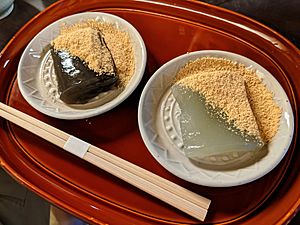
People in many cultures have eaten bracken fiddleheads for a long time. They can be eaten fresh, cooked, or pickled. Pteridium aquilinum is very popular in East Asian cooking.
In Korea, bracken is called gosari. It's a common ingredient in bibimbap, a popular mixed rice dish. Stir-fried bracken (gosari namul) is also a popular side dish.
In Japan, bracken is called warabi. It's used in soups or steamed. Warabimochi is a traditional Japanese dessert made from bracken jelly. The fiddleheads are also preserved in salt, sake, or miso.
In China, bracken is called juecai. It's eaten as a vegetable or dried for later use.
The underground stems (called rhizomes) of bracken can be ground into flour to make bread. In the Canary Islands, people used to make a porridge called gofio from the rhizomes. Both the leaves and rhizomes have also been used to make beer.
Bracken leaves are also used in the Mediterranean region to filter sheep's milk and to store fresh ricotta cheese.
The Māori people of New Zealand traditionally used P. esculentum rhizomes as a main food source. They would dry the rhizomes, then heat and soften them to suck out the starch.
Other Uses
Bracken has been used for animal bedding. This bedding then breaks down into a rich mulch that can be used as fertilizer. It is still used this way in Wales. Using bracken as a winter mulch can also help keep important nutrients like potassium and nitrogen in the soil.
Is Bracken Safe?
Bracken contains a chemical called ptaquiloside. This chemical can damage DNA and might lead to certain health problems. Some studies have looked at links between eating bracken and health issues in places like Japan and North Wales. The tiny spores released by bracken have also been studied for similar concerns.
However, ptaquiloside can be removed or destroyed. It dissolves in water and is broken down by heat (like cooking) and alkaline conditions (like soaking). Korean and Japanese cooks traditionally soak bracken shoots in water and ash to make them safer to eat. Ptaquiloside also breaks down over time at room temperature and almost completely at boiling temperature. Even so, it's a good idea to eat bracken in moderation. Some groups, like the British Royal Horticultural Society, suggest not eating bracken at all.
Ptaquiloside can also wash out of wild bracken plants and get into water supplies. This has been looked at in areas with a lot of bracken, like Wales and South America.
Uncooked bracken also has an enzyme called thiaminase. This enzyme breaks down thiamine (vitamin B1). Eating too much uncooked bracken can lead to a lack of vitamin B1, especially in animals with simple stomachs.
Bracken and Animals
The ptaquiloside in bracken can be harmful to some animals. Animals might eat bracken if there isn't enough other food, like during dry periods or after snow.
In cows, eating bracken can cause sickness. Milk from cows that have eaten bracken might also contain ptaquiloside. In pigs and horses, eating bracken can lead to a lack of vitamin B1.
Bracken and Insects
Young bracken leaves release Hydrogen cyanide when animals or insects eat them. Bracken also contains two important insect moulting hormones. If insects eat bracken, these hormones can cause them to molt too much, which leads to their death. Scientists are looking into bracken as a possible source for new insecticides.
Bracken and History
Bracken can affect old historical sites. Its strong underground root systems can damage and mix up ancient remains from periods like the Neolithic and Bronze Ages. These roots can spread very far underground, making up 90% of the plant, even if you only see the leaves above ground.
Controlling Bracken Growth
While a small amount of bracken can be good for some wildlife, too much of it can harm important habitats. Removing bracken helps other native plants and animals return. Controlling bracken can be difficult and costly. It often requires a long-term plan, not just a quick fix.
Many groups, like Natural England and the RSPB, suggest different ways to control bracken:
- Cutting: Cutting the leaves once or twice a year for at least three years.
- Crushing/Rolling: Using rollers to crush the plants, also for at least three years.
- Livestock Treading: Encouraging animals like cattle, horses, pigs, or ponies to walk on bracken areas, especially in winter. Their hooves can damage the plants and expose the roots to frost.
- Herbicides: Using special chemicals to kill the bracken. These are usually applied when the leaves are fully open so the plant absorbs the chemical well. It's important to be careful not to harm rare ferns that might be growing nearby.
- Planting Trees: Allowing trees to grow in bracken areas. The shade from the trees can stop bracken from growing. This is a long-term solution.
- Burning: Burning the dead bracken can remove the old plant material. However, bracken is good at recovering from fires, so this might not be the best long-term solution.
- Ploughing: Turning over the soil and then planting other seeds.
Any plan to control bracken needs to be followed through, or the bracken will just grow back!
Images
See also
 In Spanish: Pteridium para niños
In Spanish: Pteridium para niños


